Teaching Organizational Skills Using ABA Approaches
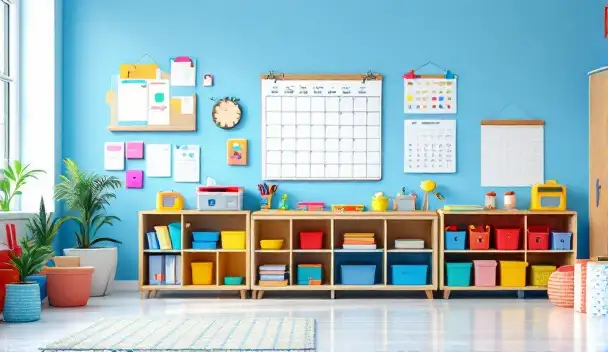
Understanding ABA in Organizational Skill Development
Teaching organizational skills is critical for individuals with autism spectrum disorder (ASD) and other developmental challenges. Applied Behavior Analysis (ABA) offers a research-backed framework for designing effective interventions that promote independence and daily functioning. This article explores how ABA techniques, particularly task analysis, behavioral skills training, and visual supports, can be employed to teach organizational skills effectively.
Core ABA Techniques for Teaching Organizational Skills
What are some ABA techniques used for teaching organizational skills?
Behavioral Skills Training (BST) is a proven method widely used within ABA to enhance organizational skills. This approach emphasizes performance and competency by having individuals demonstrate skills and attain proficiency in sequential steps. Trainers often use task analysis—a process that breaks down complex activities like dressing or organizing materials into smaller, manageable parts—to facilitate learning. For example, an activity such as packing a bag can be split into steps like gathering items, folding clothes, and placing them into the bag.
Chaining techniques, including forward and backward chaining, build on this task analysis by sequentially linking these steps. Forward chaining begins with the first step, while backward chaining starts from the last, ensuring the individual completes each component successfully. This step-by-step progression encourages mastery and confidence.
Prompting strategies are integral to guiding learners through these steps. Visual prompts such as pictures or checklists reinforce understanding, while verbal or physical prompts provide immediate assistance. The process involves fading these prompts gradually, fostering independent task completion.
Reinforcement plays a vital role in maintaining motivation. Both immediate praise and tangible rewards encourage consistent effort and successful task execution. Data collection and ongoing assessment enable practitioners to monitor progress, adapt techniques, and ensure the effectiveness of intervention plans.
Visual supports are especially helpful, serving as reminders and internal cues. Schedules, charts, and checklists help individuals stay organized and develop internal routines. When combined, these ABA techniques offer a structured, measurable framework for teaching organization skills effectively.
| Technique | Description | Example |
|---|---|---|
| Task Analysis | Breaking activities into manageable steps | Preparing meals by chopping, cooking, and serving |
| Chaining (forward/backward) | Linking steps sequentially to build routines | Completing steps of brushing teeth in order |
| Prompting Strategies | Using cues to guide behavior, fading over time | Picture schedule for morning routines |
| Reinforcement | Rewarding desired behaviors to increase likelihood | Praise for completing a task independently |
| Visual Supports | Using visual aids to facilitate learning | Checklists and visual timers |
These methodologies, integrated into ABA programs, not only teach organizational skills but also promote generalization and independence, preparing individuals for everyday functioning.
Implementing Behavioral Skills Training (BST) for Organization
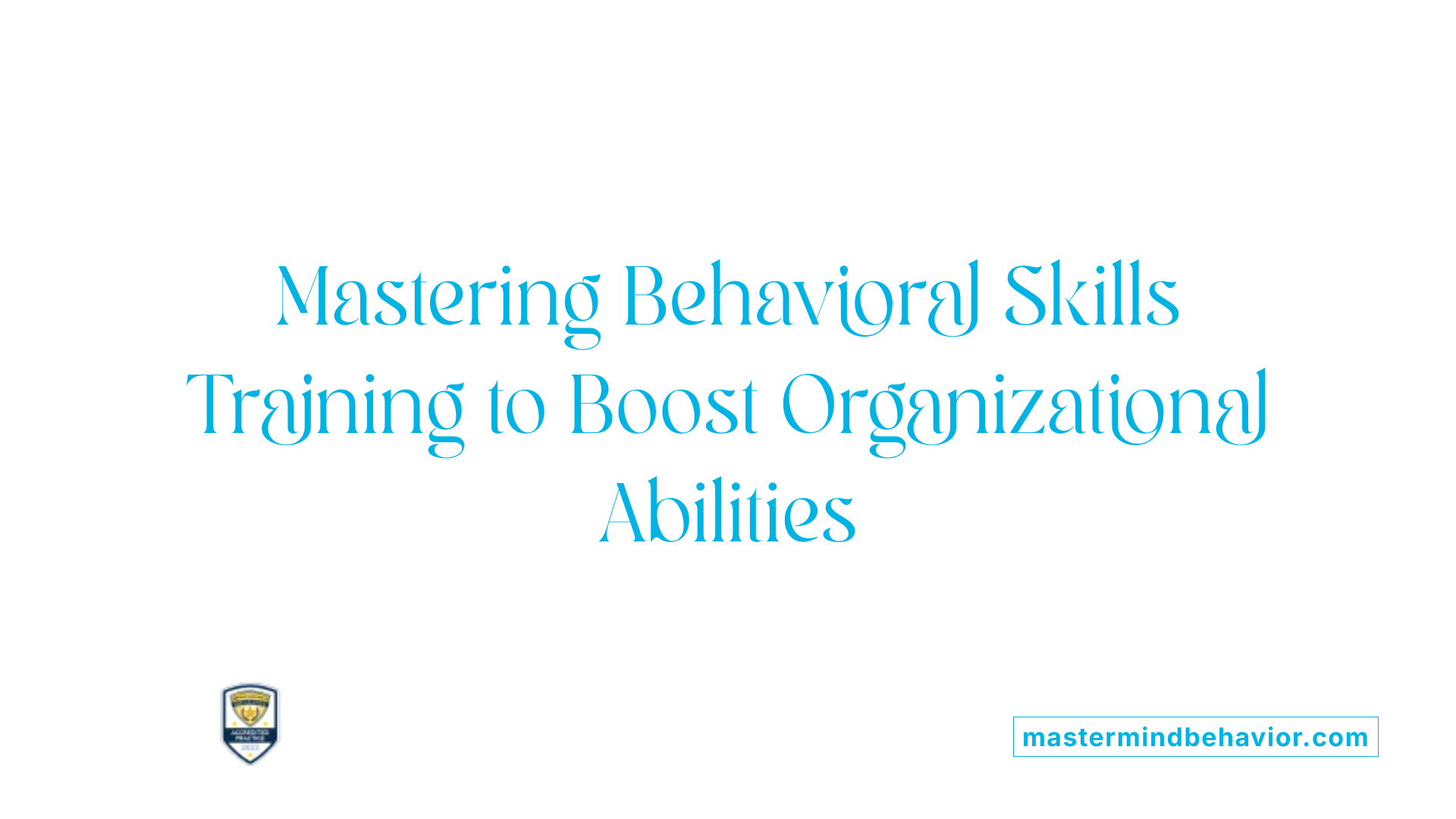
What are the components of Behavioral Skills Training (BST)?
Behavioral Skills Training (BST) is a structured, evidence-based approach used to teach a wide range of skills, including organizational abilities. It typically involves four main components:
- Instruction: Clear explanation of the target skill, outlining what is expected.
- Modeling: Demonstration of the skill by a trainer or instructor.
- Rehearsal: Opportunities for the learner to practice the skill in a controlled setting.
- Feedback: Providing constructive feedback to correct errors and reinforce proper performance.
These components work together to promote skill acquisition and ensure that learners can perform tasks accurately and consistently.
How does modeling and rehearsal enhance the training process?
Modeling allows learners to see the skill performed correctly, providing a concrete example to emulate. This visual demonstration helps learners understand what is expected and reduces uncertainty.
Rehearsal involves active practice, where the individual attempts to perform the skill under supervision. Repetition during rehearsal helps solidify the behavior, promote fluency, and build confidence.
In BST, both modeling and rehearsal are critical in fostering skill mastery. They allow trainers to identify errors promptly, adjust instructions as needed, and reinforce correct behaviors immediately.
Can BST be adapted for group and individual training settings?
Yes, BST is flexible and can be tailored to different training contexts. For small groups, trainers can conduct collective modeling and facilitate group rehearsals while providing individual feedback as necessary.
In individual training, the process can be more personalized, with targeted instruction and tailored rehearsal opportunities. This is especially useful when learners have specific needs or require more intensive support.
Group training offers efficiency and peer learning opportunities, while individual training ensures focused attention, making both approaches valuable depending on the setting.
How is the effectiveness of BST in teaching organizational skills evaluated?
Research indicates that BST is effective in improving organizational skills. Effectiveness is typically assessed through:
– Performance data: Observations of the learner completing organizational tasks correctly. – Generalization: Ability to transfer skills to real-life settings. – Maintenance: Retention of skills over time. – Feedback: Satisfaction and confidence levels from the learners.
Studies have shown that individuals trained with BST demonstrate measurable improvements in managing materials, planning activities, and completing organization-related tasks. For example, children and students often exhibit enhanced academic performance and independent functioning after BST interventions.
| Features | Description | Benefits |
|---|---|---|
| Components | Instruction, Modeling, Rehearsal, Feedback | Ensures comprehensive skill learning |
| Training Settings | Group and individual | Flexibility to meet diverse needs |
| Evaluation Methods | Performance data, generalization, maintenance | Measures success and guides adjustments |
This structured approach makes BST a versatile and effective method for teaching organizational skills in various environments, including classrooms, clinics, and homes.
Task Analysis and ABA Strategies to Build Organization
How are task analysis and other ABA strategies used to develop organizational skills?
Behavioral skills training (BST) and task analysis are essential components of applied behavior analysis (ABA) aimed at building organizational skills. Task analysis involves breaking down complex routines, such as getting ready in the morning or preparing a meal, into simple, step-by-step procedures. These steps are then taught sequentially, allowing individuals to master each part of the task.
In ABA, several methods like chaining—either forward, backward, or total task chaining—are used to teach these steps. Forward chaining teaches the first step first and gradually adds subsequent steps, while backward chaining begins with the last step to reinforce completing the entire routine. Total task chaining involves teaching all steps at once, progressively prompting and fading assistance.
Visual supports, including picture schedules, cue cards, and social stories, play a critical role in helping individuals understand and remember routines. These visual tools serve as cues, reduce anxiety, and reinforce learning by providing clear, concrete representations of each step involved.
Natural environment teaching (NET) complements structured approaches by integrating skills into everyday settings. For instance, practicing organization skills during meal prep or dressing in natural contexts helps promote generalization and real-world application.
Reinforcements—such as praise, tokens, or preferred activities—motivate learners and encourage independence. Prompting strategies, like verbal prompts or physical guidance, are used to initiate correct responses, with systematic fading ensuring the learner gains confidence and autonomy over time.
Overall, combining task analysis, chaining procedures, visual supports, reinforcement, prompting, and natural environment teaching creates a comprehensive framework. This approach not only teaches individuals how to efficiently organize routines but also supports the generalization of these skills across different settings and activities.
How can visual supports and cues aid in developing organizational skills?
Visual supports—such as schedules, picture cues, and visual timers—serve as external aids that help individuals understand what is expected and what comes next in a routine. They reduce reliance on verbal instructions, which can be overwhelming or confusing, especially for individuals with autism or other developmental disabilities.
Using visual cues improves memory, increases independence, and decreases frustration. For example, a visual schedule displaying pictures of each step involved in brushing teeth allows the individual to independently follow the routine without constant prompts.
These tools also facilitate smooth transitions between activities, help in recognizing task completion, and support self-monitoring. Frequently, visual supports are combined with reinforcement strategies to strengthen organizational behaviors.
How can natural environment teaching be integrated into building organizational skills?
Natural environment teaching (NET) involves teaching skills through tasks that occur in the learner’s usual environment, making learning more relevant and enduring. When focusing on organizational skills, NET might include practicing a task during real-life routines, like setting the table during mealtime or organizing toys during play.
This method encourages learners to apply skills in contexts that matter most to them, boosting motivation and engagement. It also ensures that skills are functional and easily transferable to everyday life.
Integrating ABA strategies such as prompting, reinforcement, and fading within natural contexts ensures that skills are maintained over time and across different environments. The goal remains fostering independence and reducing reliance on adult prompts.
| Strategy | Description | Benefit |
|---|---|---|
| Task analysis | Breaking routines into small steps | Simplifies learning; promotes independence |
| Chaining (forward/backward/total) | Linking steps in sequence, teaching in order | Structured skill building; gradual independence |
| Visual supports | Pictures, schedules, cues | Enhances understanding; accessible and motivating |
| Reinforcement | Rewards, praise, preferred activities | Motivates learning; encourages consistency |
| Prompting and Fading | Guidance to complete tasks, gradually reducing prompts | Builds independence; minimizes prompt dependency |
| Natural Environment Teaching | Real-life context practice | Promotes generalization; makes learning functional |
Through these combined methods, individuals can effectively learn to manage routines and organize their daily activities, ultimately leading to increased independence and quality of life.
Research Evidence and Methodologies Supporting ABA Interventions
What research and methodologies support ABA-based training for organizational skills?
Applied Behavior Analysis (ABA) offers a range of evidence-based strategies that have proven effective in teaching organizational skills, especially to children and individuals with autism spectrum disorder (ASD). These methodologies are grounded in structured, systematic approaches that break down complex tasks into manageable steps.
One foundational technique is task analysis, which decomposes multi-step activities like brushing teeth or putting on pants into simple, sequential steps. This allows learners to master each part before progressing, ensuring understanding and retention. Task analysis is often combined with prompting—strategies such as visual cues or physical guidance—to support successful completion, and reinforced with positive reinforcement that is meaningful to the individual.
Structured techniques like Discrete Trial Training (DTT) further facilitate learning by presenting clear instructions and providing immediate reinforcement. DTT is particularly effective in teaching specific organizational behaviors, such as sequencing steps for packing a bag or organizing materials. These methods have demonstrated significant improvements in task planning and execution, with measurable progress documented through ongoing data collection.
Furthermore, newer approaches like the Early Start Denver Model (ESDM) and Pivotal Response Treatment (PRT) incorporate naturally occurring routines and interests of learners. These strategies focus on establishing motivation and generalization of skills across environments, making the learning process more engaging and functional.
Visual supports are an integral component of successful ABA interventions, especially for teaching organizational skills. Use of visual schedules, checklists, and visual cues helps individuals understand expected routines and sequences. Clear, visual instructions reduce confusion and increase independence.
Research from reputable sources, including the National Institute of Mental Health, along with numerous case studies, show that ABA interventions can produce substantial gains. Evidence indicates that children with ASD who are taught organizational skills through these methodologies demonstrate improved planning, sequencing, and task completion.
In summary, the combination of task analysis, reinforcement, prompting, visual aids, and naturalistic strategies form a robust, evidence-supported framework for developing organizational skills within ABA. These systems are adaptable, measurable, and effective, particularly when tailored to individual needs and combined with ongoing assessment and support.
Educational Strategies for Teaching Daily Living and Organization Skills
What educational strategies are effective for teaching daily living and organizational skills to individuals with autism spectrum disorder?
Teaching daily living and organizational skills to individuals with autism spectrum disorder (ASD) requires a thoughtful combination of methods that are systematic, visual, and behaviorally grounded. These strategies are designed to improve independence and help individuals manage everyday tasks with confidence.
One of the most effective approaches involves the use of visual supports. These include schedules, visual checklists, picture cues, and icons. Visual supports serve to clarify routines, help in managing transitions between activities, and improve memory of complex tasks. For example, a visual schedule displaying each step involved in brushing teeth or washing hands can guide an individual through each task clearly.
In addition to visual tools, positive reinforcement plays a vital role. Reinforcing desired behaviors immediately and consistently encourages skill acquisition and maintains motivation. Reinforcements can be small rewards, praise, or access to preferred activities, tailored to each individual.
Modeling behaviors is another essential strategy. Demonstrating the correct way to perform a task allows learners to imitate and learn skills through observation. Repeated modeling, combined with practice, helps in solidifying routines.
Creating systematic routines and predictable environments further supports learning. Establishing consistent patterns allows individuals to anticipate what comes next, reducing anxiety and promoting independence. Clear expectations set boundaries and help the learner understand the desired behavior.
Environmental modifications also contribute significantly. Organizing personal belongings systematically, reducing sensory overload in the environment, and making relevant items easily accessible support focus and task completion.
Collaborating with families and caregivers is crucial for generalization. Sharing strategies, using social stories, and coaching families to reinforce skills at home help maintain progress outside the learning environment.
Naturalistic teaching methods, which incorporate learning into everyday activities and routines, enhance engagement and facilitate skill transfer.
In summary, effective teaching strategies for individuals with ASD involve a mix of visual supports, behavioral reinforcement, modeling, consistent routines, environmental organization, and family collaboration. These combined approaches create a structured learning experience tailored to each person’s needs, fostering greater independence in daily living and organizational skills.
| Strategy | Description | Benefits |
|---|---|---|
| Visual Supports | Schedules, checklists, picture cues | Clarify routines, aid memory, reduce anxiety |
| Positive Reinforcement | Rewards, praise, preferred activities | Motivate learning, increase desired behaviors |
| Modeling Behaviors | Demonstrating tasks to imitate | Facilitate students' understanding of procedures |
| Systematic Routines | Consistent daily patterns | Promote predictability, reduce stress |
| Environmental Setup | Organized spaces, sensory adjustments | Improve focus, ease of task completion |
| Family Collaboration | Training caregivers, social stories | Support skill transfer and consistency |
Understanding and applying these strategies can significantly improve the acquisition and retention of daily living and organizational skills, empowering individuals with ASD to become more independent in their everyday lives.
Role of Visual Supports and Reinforcement
How do visual cues support learning?
Visual supports are essential tools used alongside ABA teaching methods to enhance understanding and retention of skills. These include schedules, picture cards, visual replicas of tasks, and other visual aids. They help learners, especially those with ASD, by providing clear, concrete cues that guide behavior and sequence activities.
Using visual cues simplifies complex information, making it more digestible for individuals who may struggle with auditory instructions or abstract concepts. For example, a visual schedule displaying pictures of brushing teeth stages helps a child understand and follow through each step independently.
Additionally, visual supports can be tailored to individual needs, making instructions more accessible and reducing confusion or frustration.
How are rewards and praise used in ABA?
Reinforcement is a cornerstone of ABA, often delivered through rewards and positive praise. Rewards can include tangible items like toys or snacks, or social praise such as verbal affirmations and gestures like clapping or smiling.
Effective reinforcement encourages the repetition of desired behaviors, promoting skill acquisition and maintenance. Teachers and caregivers are trained to deliver praise immediately after the target behavior, emphasizing specific actions, such as "Great job putting on your pants!".
Incorporating rewards and praise not only boosts motivation but also helps build positive emotional associations with learning activities. These strategies foster engagement and reinforce the connection between effort and positive outcomes.
What role do checklists and schedules play in teaching organizational skills?
Checklists and schedules are practical visual tools used to teach organizational and daily living skills. These tools break down complex tasks into manageable steps, providing structure and predictability.
A typical schedule might include images or words representing morning routines—brush teeth, get dressed, eat breakfast—organized chronologically. Checklists serve as a layered version, allowing learners to check off completed activities.
Research shows that consistent use of schedules and checklists promotes independence and reduces anxiety. They help individuals recognize their responsibilities, stay on task, and understand the sequence of tasks.
How do visual supports foster independence?
Visual supports empower learners to perform tasks more independently by providing clear cues and structured guidance. When individuals internalize these visual cues, they can follow routines without constant adult prompts.
For example, a picture schedule for cleaning up after an activity encourages the learner to complete all steps autonomously. Over time, reliance on visual supports decreases as internal skills strengthen.
Moreover, visual supports can be adapted to various environments—home, school, community—ensuring consistency across settings. This consistency supports generalization of skills and promotes greater self-sufficiency.
| Aspect | Description | Impact on Learning |
|---|---|---|
| Visual cues | Pictures, symbols, schedules | Clarifies tasks, reduces confusion |
| Rewards and praise | Tangible items, social affirmations | Reinforces behaviors, increases motivation |
| Checklists and schedules | Step-by-step visual plans | Develops organizational skills, independence |
| Support for independence | Visuals enable autonomous task completion | Fosters self-sufficiency, confidence |
Examples of visual supports for organizational skills
| Task | Visual Support Used | Outcome | Additional Notes |
|---|---|---|---|
| Brushing teeth | Picture sequence showing each step | Accurate performance | Customizable for individual needs |
| Washing hands | Visual checklist for each step | Better hygiene routines | Reinforces proper technique |
| Putting on clothes | Visual schedule with images | Faster dressing, independence | Can include choice options |
| Eating yogurt | Visual cue card with steps | Encourages self-feeding | Especially useful for young children |
Visual supports are a powerful element in ABA to teach and reinforce organizational skills. They ensure clarity and consistency, making daily routines more manageable and fostering greater independence for individuals with diverse learning needs.
Monitoring Progress and Data Collection in ABA
How is behavioral data collection conducted in ABA?
In ABA, tracking behavioral data is essential for understanding how well an individual is progressing with targeted skills. Data collection involves recording specific information about behavior frequency, duration, or intensity, depending on the skill being taught. Practitioners often use straightforward tools like checklists, tally sheets, or digital data entry systems to gather consistent and accurate information.
For example, if a child is learning to brush their teeth independently, data might include the number of steps completed correctly or the amount of time taken to finish the task. Consistent data collection allows for clear visualization of progress and helps determine whether the current intervention approach is effective.
How is progress monitored over time?
Progress monitoring in ABA involves regularly reviewing collected data to assess how well an individual is acquiring and maintaining skills. This usually occurs weekly or monthly, where practitioners analyze trends — whether improvements are steady, plateauing, or declining.
Visual charts and graphs play a vital role in this process, providing easy-to-understand representations of progress. By observing these patterns, ABA therapists can identify when behaviors are increasing as desired or if they need adjustment.
How are individualized adjustments made based on data?
Data-driven decisions guide modifications to intervention plans. If data indicates insufficient progress, practitioners may alter prompts, change reinforcement strategies, or break down tasks into smaller steps using task analysis.
For example, if a child struggles with social interactions, assessments might reveal difficulty with turn-taking. The therapy plan might then focus on more explicit skill-building, such as practicing eye contact and waiting for a turn, reinforced through immediate praise and rewards.
Adjustments are personalized, depending on the individual's strengths, preferences, and response patterns. Continuous data collection ensures that interventions stay aligned with the person's evolving needs.
How is overall outcome evaluation carried out?
Evaluating overall outcomes involves comparing initial skill levels with current performance data. Standardized assessments, behavioral checklists, and functional analyses help determine if goals are met.
Linking progress to broader developmental milestones or daily functional improvements confirms the effectiveness of ABA strategies. It also informs whether new goals should be set or existing interventions need expansion.
Comprehensive outcome evaluations are often shared with families and other stakeholders, ensuring transparency and collaborative decision-making. Celebrating success and identifying areas needing further support motivate continued improvement.
| Aspect | Method | Tools | Purpose |
|---|---|---|---|
| Data collection | Continuous and systematic | Checklists, digital systems | Track specific behaviors and skill acquisition |
| Progress monitoring | Regular review | Charts, graphs, trend analysis | Visualize improvements over time |
| Individualized adjustments | Data-informed modifications | Task analysis, reinforcement adjustments | Personalize interventions to maximize success |
| Outcome evaluation | Comparative assessment | Standardized tests, functional analysis | Confirm achievement of goals and guide future planning |
Understanding and implementing effective progress tracking methods in ABA is crucial for promoting meaningful change. It ensures that interventions are responsive, evidence-based, and tailored to the individual’s unique developmental path.
Addressing Social and Emotional Components of Organization
How does ABA target social skills development?
Applied Behavior Analysis (ABA) places a strong emphasis on improving social skills for individuals with autism spectrum disorder (ASD). It focuses on breaking down complex social interactions—such as sharing, turn-taking, and joint attention—into manageable parts using task analysis. This structured approach allows learners to master each step before moving on to the next, resulting in more effective social engagement.
ABA employs various teaching strategies such as discrete trial instruction and modeling to reinforce positive social behaviors. Visual supports like schedules, social stories, and cue cards help learners understand expected behaviors and recognize social cues. Ongoing assessment and feedback from caregivers and teachers further ensure that progress is measurable and tailored to each individual's needs.
Parents are actively encouraged to reinforce these skills at home through consistent practice, demonstrating proper social interactions, and creating environments that support social learning. Recognizing and celebrating small successes motivate continued development and foster confidence in social settings.
Why is emotion regulation important, and how does ABA support it?
Emotion regulation—the ability to manage one’s emotional responses—is vital for overall social functioning and mental well-being. Individuals with ASD often face difficulties in recognizing, understanding, and controlling emotions.
ABA strategies address these challenges through teaching coping mechanisms, use of social stories, and relaxation techniques. For example, social stories can depict typical emotional situations and appropriate responses, helping individuals learn to identify feelings and adopt suitable behaviors.
In addition, reinforcement of calm, appropriate responses—and the systematic teaching of self-regulation skills—help decrease maladaptive behaviors related to emotional distress. This approach is complemented by sensory processing interventions when emotional dysregulation is linked to sensory sensitivities.
How can self-monitoring enhance social and emotional skills?
Self-monitoring refers to teaching individuals to observe and evaluate their own behavior, emotions, and social interactions. When integrated into ABA programs, it promotes increased independence and awareness.
Skills are taught through structured activities where individuals record their behaviors, feelings, or reactions, often using visual prompts or checklists. This process encourages reflection, making them aware of their own progress and areas needing improvement.
Self-monitoring techniques have been shown to improve engagement, emotional regulation, and social skills significantly. They also empower individuals to apply these skills across different environments and situations, supporting generalization.
Visual support tools and their role in teaching social and emotional skills
Visual supports like schedules, cue cards, and picture exchange communication systems (PECS) are integral to ABA interventions aimed at enhancing social interactions and emotional understanding. They provide clear, concrete cues that help reduce anxiety, clarify expectations, and facilitate communication.
These tools enable learners to predict upcoming social events, recognize emotional states, and practice appropriate responses. For instance, emotion cards depicting various feelings can help children identify their own emotions and understand others’ feelings, fostering empathy.
Table: Summary of Strategies and Tools Used in ABA for Social and Emotional Skills
| Strategy/Tool | Application | Targeted Skill | Additional Notes |
|---|---|---|---|
| Discrete Trial Instruction | Repetition and reinforcement of social steps | Learning social behaviors like greeting or sharing | Uses structured sessions with clear prompts |
| Modeling | Demonstrating appropriate social responses | Imitation of desired behaviors | Often combined with reinforcement |
| Visual Schedules and Cue Cards | Providing visual guidance | Understanding routines and emotional cues | Supports transition and emotional awareness |
| Social Stories | Narratives about social situations | Recognition of social norms, emotional responses | Tailored to individual experiences |
| Self-Monitoring Checklists | Tracking personal behavior and feelings | Self-awareness, behavioral regulation | Promotes independence and self-assessment |
| Reinforcement Systems | Rewards for social and emotional progress | Motivation and generalization | Involves caregivers for consistency |
How do ABA interventions promote overall social-emotional growth?
ABA’s comprehensive approach combines structured teaching, visual supports, reinforcement, and caregiver involvement to foster social competence and emotional resilience. By systematically breaking down skills, providing visual cues, and encouraging self-monitoring, individuals with ASD develop the ability to navigate social landscapes more effectively.
This collaborative process—encompassing families, educators, and therapists—ensures consistent, personalized strategies that align across different settings. Over time, these practices lead to meaningful improvements in communication, emotional regulation, and social participation, enriching the individual's overall quality of life.
Collaborative Approach with Families and Professionals
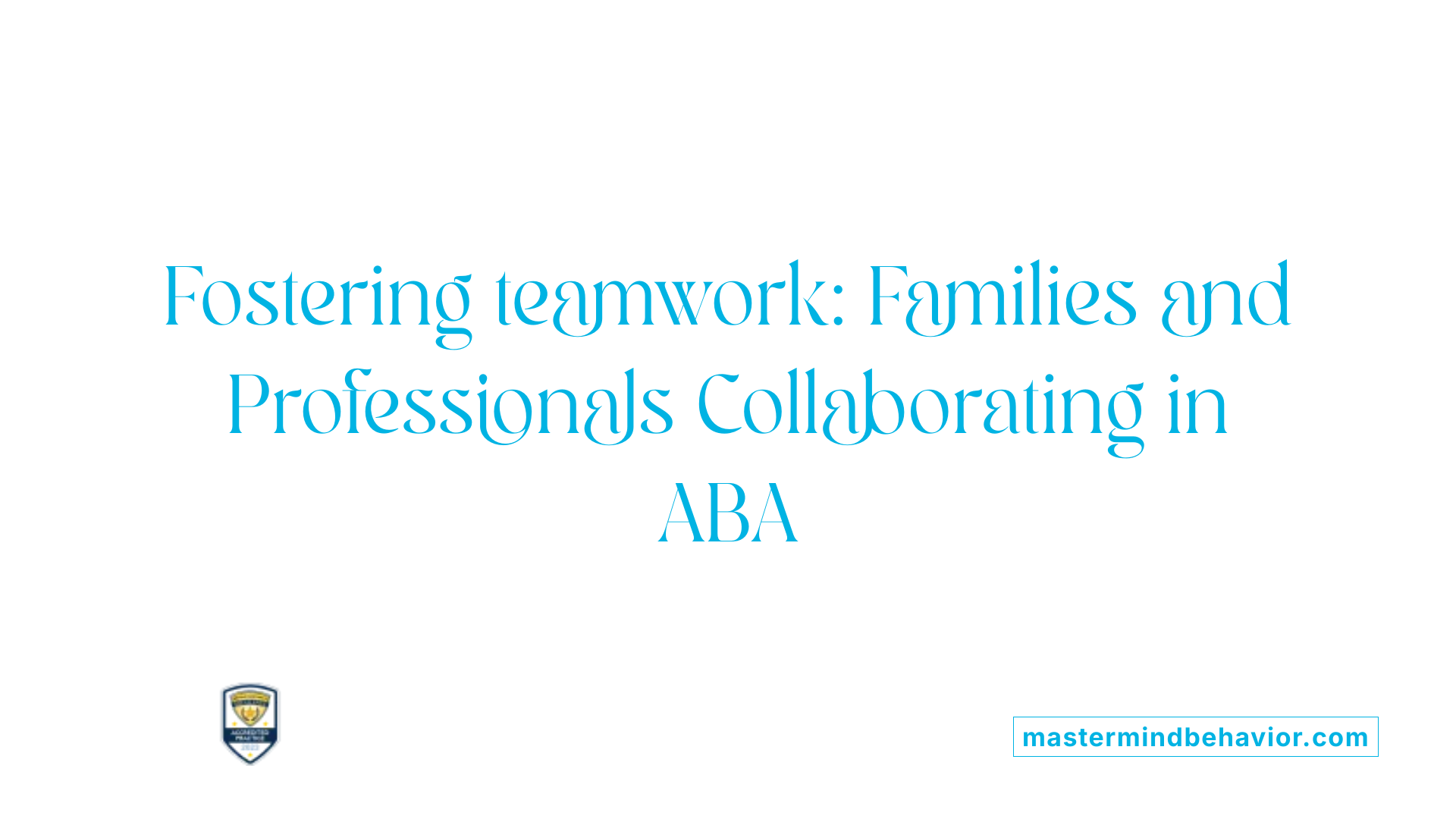
How does family involvement enhance ABA interventions in organizational skills training?
Family involvement plays a vital role in reinforcing and generalizing skills learned during ABA therapy, especially in organizational skills training. When families actively participate, they can help maintain consistency, monitor progress, and support skill application across different settings. For example, using visual schedules and step-by-step task analysis at home enables children to practice organizational routines, such as packing their bag or managing personal hygiene, in a familiar environment. Parents and caregivers are encouraged to practice techniques introduced during therapy, like prompting and reinforcement, which promote discipline and independence.
Effective family participation also involves educating caregivers about the behaviors targeted during training. This understanding allows them to implement strategies like systematic reinforcement or social stories that reinforce social skills and emotional regulation outside the clinical setting. Regular communication between therapists and families fosters collaborative adjustments tailored to the child's needs, ensuring consistency and maximizing intervention success.
Why is interdisciplinary collaboration essential in ABA for organizations?
ABA programs benefit significantly from an interdisciplinary approach, involving psychologists, speech therapists, occupational therapists, and educators. Such collaboration ensures comprehensive support addressing various developmental domains, including communication, sensory processing, and social interaction.
Organizational skills often intersect with other cognitive and behavioral functions. For example, developing a visual schedule might involve both behavioral techniques and sensory considerations from occupational therapy. Regular team meetings and shared data collection enable an integrated understanding of the child's progress, allowing therapy plans to be adapted holistically.
By pooling expertise, professionals can develop cohesive strategies for using task analysis, reinforcement systems, and behavioral goals. This integration prevents conflicting approaches, promotes consistency, and accelerates learning outcomes for individuals with autism.
How do we train caregivers to implement ABA strategies effectively?
Training caregivers is a cornerstone for successful behavioral intervention. Caregivers are taught to understand the principles of ABA, including reinforcement, prompting, and data recording.
Training methods include hands-on demonstrations, role-playing, and review sessions to ensure they can apply techniques accurately. Pyramidal training models are often employed, where a senior therapist trains staff, who then instruct family members, thus scaling the training efficiently.
Practical training focuses on teaching specific skills like breaking down daily routines using task analysis, responding to behaviors, and utilizing visual supports. Ongoing support, feedback, and booster sessions help caregivers refine their skills, increasing confidence and consistency in implementation.
What practices ensure consistent implementation of ABA techniques?
Consistency is critical in ABA to ensure skills are learned and maintained. Establishing routines and routines helps embed new behaviors into daily life.
Caregivers and professionals are encouraged to use similar prompts, reinforcement schedules, and task analysis procedures across settings. Caregivers are also trained to collect data, monitor progress, and adjust strategies as needed, fostering a data-driven approach.
Regular meetings for reviewing progress, addressing setbacks, and celebrating successes promote cohesion among team members. Visual supports like schedules or cue cards serve as reminders for everyone involved. Additionally, creating a supportive environment where all parties understand their roles enhances adherence and effectiveness.
| Aspect | Strategy | Benefit | Additional Notes |
|---|---|---|---|
| Family involvement | Home practice of routines | Reinforces skills | Use visual schedules and prompts |
| Interdisciplinary collaboration | Regular team meetings | Holistic support | Sharing data and adjusting plans |
| Caregiver training | Interactive workshops and follow-ups | Increased confidence | Use pyramidal training models |
| Consistent implementation | Standardized procedures | Skill retention | Use visual supports and systematic data collection |
Enhancing Engagement and Reducing Barriers
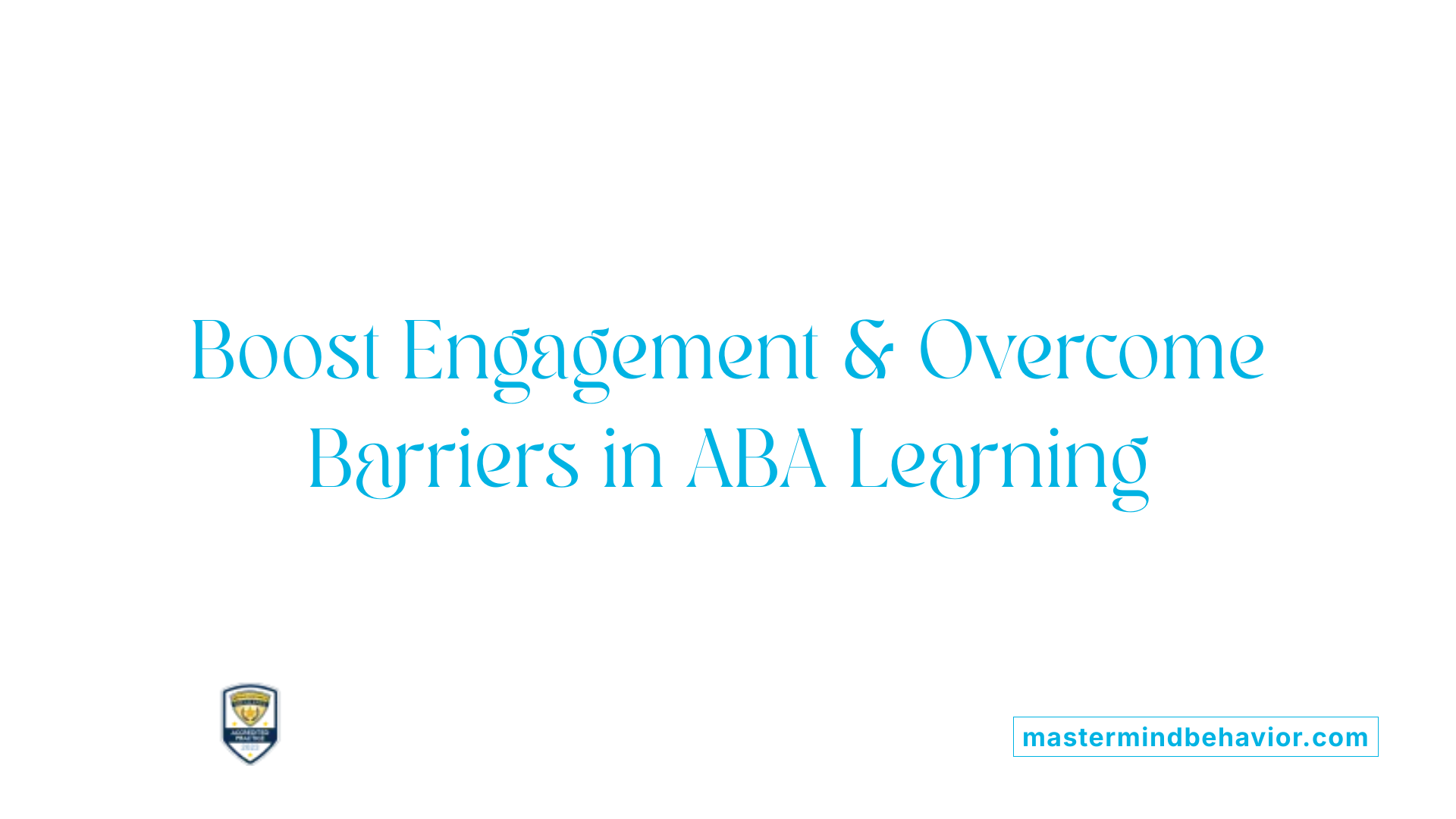
How can considering individual preferences improve engagement?
In ABA therapy, recognizing each person's unique likes, interests, and motivators plays a crucial role in boosting engagement. Tailoring activities and reinforcement to individual preferences ensures that the learner is more motivated and willing to participate. For example, if a child shows a strong interest in a specific toy or activity, incorporating it into sessions can increase their willingness to engage and learn.
Moreover, individual preferences help create a supportive learning environment, reducing resistance and frustration. When learners feel that their likes are acknowledged and integrated into activities, their emotional comfort increases, leading to more meaningful participation.
What are reinforcement schedules, and why are they important?
Reinforcement schedules are predefined plans for delivering rewards to reinforce desired behaviors. They are essential in ABA because they help maintain motivation and promote skill acquisition. Different schedules, such as continuous reinforcement (rewarding every correct response) or intermittent reinforcement (rewards given sporadically), are used based on the goal.
Implementing varied reinforcement schedules prevents predictability, which can increase persistence and independence. For instance, using a variable ratio schedule (rewards after unpredictable responses) can produce high rates of responding, making behaviors more durable over time.
How do active participation techniques enhance learning?
Active participation encourages individuals to be actively involved in their learning process. Techniques such as peer modeling, role-playing, and guided practice foster engagement by making tasks interactive and meaningful.
In ABA, active participation can be increased through prompts, interactive activities, and opportunities for the learner to practice skills in real-life contexts. These strategies not only promote better retention but also help generalize skills across settings.
Combining strategies for effective engagement
Integrating individual preferences, reinforcement schedules, and active participation techniques can create a comprehensive approach that addresses diverse learning needs. For example, a child might be offered a preferred activity as reinforcement, actively participate through role-play, and receive rewards on a variable schedule. This combination keeps the learner motivated, involved, and progressing.
Visual examples of engagement strategies
| Strategy | Description | Example | Effectiveness Indicator |
|---|---|---|---|
| Personalized Reinforcement | Tailoring rewards to individual interests | Using a child's favorite toy as a reward | Increased willingness to participate |
| Variable Reinforcement | Rewards delivered unpredictably to sustain motivation | Giving praise randomly after responses | Longer engagement periods |
| Active Participation | Encouraging learners to actively perform tasks | Role-playing social interactions | Better skill retention |
Final thoughts
Implementing these strategies requires careful planning and ongoing assessment. Keeping the focus on each individual's preferences and needs enhances motivation and reduces barriers to learning. Consistently applying reinforcement schedules and active participation techniques creates a dynamic and supportive environment conducive to growth and development in ABA therapy.
Building Generalization and Maintenance of Skills

How does ABA promote skill transfer in natural environments?
Applied Behavior Analysis (ABA) encourages the application of learned skills across various settings, not just the structured therapy environment. To facilitate this, practitioners systematically plan to generalize skills within real-life contexts such as home, school, and community locations. Using visual supports, familiar routines, and role-playing inside and outside therapy settings helps individuals apply new skills naturally.
In everyday environments, small modifications—like placing visual schedules in the home or using social stories—reinforce learned behaviors. These strategies enable children and adults with autism to adapt skills like social interactions and organizational routines seamlessly across different surroundings.
What role do community settings play in maintaining skills?
Community settings are vital for maintaining and strengthening skills gained through ABA. By practicing skills in places like grocery stores, parks, and restaurants, individuals learn to use these behaviors in diverse situations, which enhances their independence and confidence.
Staff members, family, and community caregivers are often trained to embed these skills into daily routines. For example, a person might practice asking for items politely or following safety rules in various community scenarios, ensuring that skills are not limited to the clinical setting.
Why are follow-up sessions essential for sustaining progress?
Follow-up sessions are an integral part of ABA programs, serving to reinforce skills and address challenges that may emerge over time. These sessions provide ongoing assessment and adjustment of strategies to ensure that skill acquisition remains robust.
Regular check-ins help track progress, gather feedback from caregivers, and troubleshoot issues as they arise. They also help in preventing regression, especially during transitions or after changes in the individual’s environment.
How is skill reinforcement managed over time?
Reinforcement plays a crucial role in maintaining behaviors once they are learned. Consistent positive reinforcement, using preferred items or activities, encourages the continued use of target behaviors.
To sustain motivation, reinforcement schedules may transition from continuous to intermittent, gradually reducing prompts to foster independence. Celebrating small successes publicly and privately helps embed these skills into daily routines.
Practical strategies for building generalization and maintenance
| Strategy | Description | Example |
|---|---|---|
| Environment modification | Adjusting physical settings to promote natural use of skills | Using visual schedules on the fridge to encourage routine habits |
| Community-based practice | Practicing skills in real-world settings | Role-playing shopping or crossing the street in community parks |
| Caregiver training | Educating caregivers on reinforcing and promoting skills | Training parents to prompt social interactions at home |
| Data collection and review | Monitoring progress to inform ongoing interventions | Regular assessments to adapt strategies as needed |
| Incorporating interests | Using personal interests to motivate learning | Teaching communication through favorite toys or topics |
Collaboration for effective generalization
Successful skill transfer relies on collaboration between therapists, families, and community members. By sharing insights and strategies, all parties can promote consistency and help the individual navigate different environments confidently.
Overall, systematic planning and ongoing support ensure that skills learned through ABA are sustained and generalized effectively across settings, improving the individual's ability to function independently and successfully in daily life.
Innovative and Emerging ABA Techniques for Organization
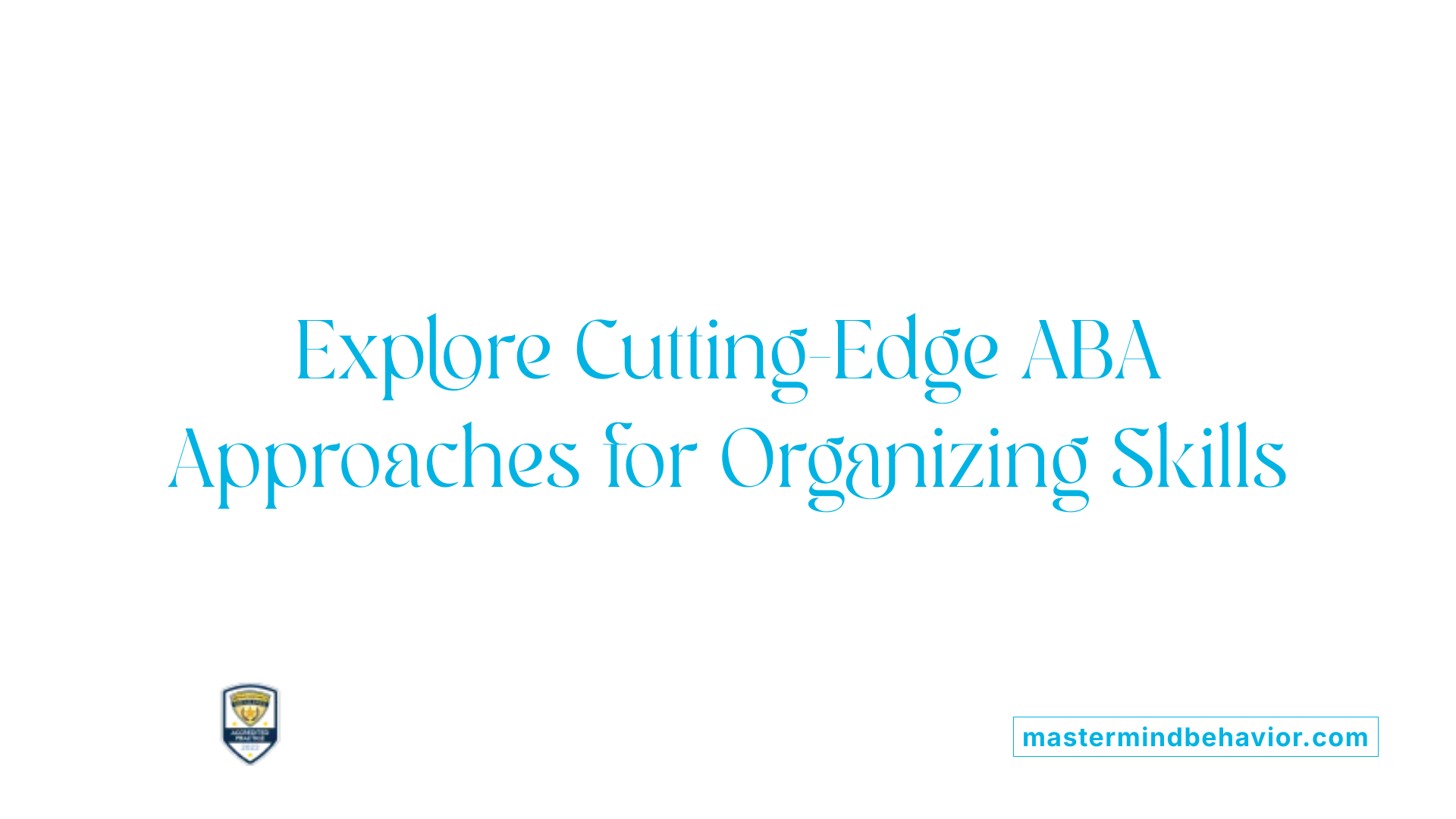
How is technology-assisted learning being integrated into ABA for organizational skills?
Technology-assisted learning is increasingly playing a vital role in ABA interventions aimed at teaching organizational skills. Digital tools such as apps, interactive software, and online platforms enable individualized, engaging, and adaptable instruction. For example, visual schedules and task breakdowns can be delivered via tablets, allowing users to access step-by-step instructions at their own pace.
These tools often include features like prompting, immediate feedback, and progress tracking. They help make complex tasks manageable by providing clear visual cues, timers, and reinforcement systems. Additionally, data collection becomes seamless with digital platforms, giving therapists and parents instant insights into progress and areas needing further support.
What impact does virtual training have on ABA practices?
Virtual training has revolutionized how practitioners learn and implement ABA techniques. Online courses, webinars, and video conferencing enable trainers to reach staff across distant locations without the need for physical presence. This flexibility expands access to high-quality instruction and supports large-scale training efforts.
Research indicates that virtual training, when combined with performance-based assessments, can be equally effective as in-person training. Practitioners can observe demonstrations, participate in role-playing exercises, and receive immediate feedback remotely. This approach significantly enhances the scalability and consistency of ABA interventions.
How does gamification enhance learning and skill acquisition?
Gamification introduces game-like elements—such as point systems, levels, badges, and rewards—into ABA training and intervention activities. This method increases motivation, engagement, and perseverance, especially when working with children or individuals prone to disengagement.
For example, teaching organizational skills through a game can involve completing a series of steps, earning points for each correct sequence, and unlocking new levels as skills improve. Such techniques leverage intrinsic motivation and make learning enjoyable, which can lead to better retention and mastery of skills.
Benefits of technology-assisted, virtual, and gamified ABA training
| Attribute | Description | Benefits |
|---|---|---|
| Accessibility | Reaching staff and learners remotely | Increased reach, flexibility, cost-effectiveness |
| Engagement | Utilizing interactive and game-like platforms | Higher motivation, sustained participation |
| Data Tracking | Automated collection and analysis | Improved accuracy, real-time assessment |
| Customization | Tailoring content to individual needs | More effective learning experiences |
Future directions in ABA for organization skills
Emerging trends include integrating artificial intelligence for adaptive learning, augmented reality for immersive tasks, and wearable devices for real-time monitoring. These advancements aim to make ABA more personalized, efficient, and accessible.
Through leveraging technology, virtual platforms, and gamification, ABA practitioners can enhance their instructional strategies, making organization skills training more engaging and effective. These innovations promise to continue improving outcomes for individuals with autism and other developmental challenges.
Summary and Future Directions
How does behavioral skills training (BST) enhance behavior change training?
Behavioral Skills Training (BST) is a proven, evidence-based approach focused on training human service personnel to effectively implement behavior change procedures. It emphasizes performance and competence, ensuring trainees demonstrate and master skills through observation, practice, and proficiency assessments. Trainers guide staff by demonstrating techniques, allowing trainees to practice, and providing feedback to achieve mastery.
What is pyramidal training, and what advantages does it offer?
Pyramidal training operates on a hierarchical model, where a senior trainer teaches a group of staff, who then train additional staff members. This approach significantly reduces the trainer’s time commitment and leverages peer-to-peer learning. The study shows that staff trained using BST within a pyramidal structure can successfully train others, ensuring skills are transferred efficiently across large teams.
How can this method benefit large-scale training initiatives?
Using pyramidal training combined with BST is especially advantageous when training numerous staff members across different locations. It enables rapid dissemination of skills, maintains consistency, and ensures that all team members perform behaviors correctly. This structure supports scalable and sustainable training programs.
What is task analysis, and how is it applied in ABA?
Task analysis is a teaching technique that dissects complex activities into smaller, manageable steps, transforming them into teachable units. In ABA, it is essential for teaching organizational skills, such as daily living tasks like brushing teeth or putting on pants. Techniques include chaining (forward and backward), discrete trial instruction, and modeling. Implementing task analysis allows individuals with ASD to learn practical skills efficiently.
What makes task analysis effective?
Effective task analysis depends on systematic instruction, consistency, and personalizing steps to individual needs. Visual supports like schedules, cards, and replicas reinforce learning, making complex tasks easier to understand and execute. This approach promotes independence and confidence in performing daily activities.
What are some practical tasks that benefit from ABA’s breakdown approach?
Everyday activities such as brushing teeth, washing hands, dressing, and eating yogurt can be broken down into smaller, sequential steps. Teaching these tasks with ABA techniques involves presenting each step clearly, providing prompts, and reinforcing correct completion, leading to mastery and independence.
How does ABA foster social skills development?
ABA emphasizes structured, measurable strategies to enhance social interactions, including communication, joint attention, turn-taking, sharing, and emotion regulation. By breaking down complex social situations into smaller parts, individuals can learn and practice appropriate responses progressively. Visual supports, modeling, and reinforcement strengthen social skills.
What is the role of caregivers and professionals in developing social skills?
Parents and teachers play a vital role in reinforcing social skills at home and in the community. Consistent practice, positive reinforcement, and creating supportive environments encourage skill generalization. Progress is monitored through assessments and feedback, celebrating small milestones to motivate continued development.
How has ABA evolved over the past 60 years?
Over six decades, ABA has expanded to cover a broad array of issues such as emotional regulation, executive functioning, sensory processing, and communication. Its flexibility allows personalized interventions targeting internal cues like hunger or emotional states through behavior management strategies involving reinforcement, prompting, and data collection.
How does ABA support executive functioning and emotional regulation?
ABA programs foster skills like goal setting, self-monitoring, and shaping behaviors to improve executive functioning. Emotional regulation techniques include teaching coping strategies, using social stories, and relaxation training. These methods help individuals manage stress, frustration, and emotional responses.
What strategies address engagement, fatigue, and sensory processing issues?
Engagement is promoted by incorporating personal preferences, using reinforcement schedules, and employing active participation techniques. To combat fatigue, tasks are gradually increased in duration, leveraging behavioral momentum. Sensory processing difficulties are supported through sensory diets, desensitization, and environmental adaptations.
How are communication and sensory issues managed?
Communication challenges are addressed with interventions like Picture Exchange Communication System (PECS), augmentative and alternative communication (AAC), mand training, and natural environment teaching. Reinforcing all attempts encourages expressive communication. Sensory issues are tackled with systematic desensitization and teaching appropriate sensory behaviors, enabling better integration.
In what ways does ABA promote recognizing and building on individual strengths?
Through ongoing assessment and a strength-based approach, ABA emphasizes recognizing individual abilities and potential. Techniques such as generalization and reinforcement help learners apply skills across contexts, fostering independence and self-confidence.
How do sensory and proprioceptive skills contribute to overall development?
Managing sensory processing issues with activities promoting body awareness and exercises targeting proprioception enhances overall development. Reinforcement encourages engagement in structured exercises, supporting motor coordination, balance, and spatial awareness.
Why is collaboration among families and professionals vital?
Effective ABA interventions rely on a team approach, involving families, educators, therapists, and other professionals. Consistent, coordinated efforts ensure comprehensive support, reinforce learning across environments, and promote holistic development.
Future of ABA organizational skills training
Looking ahead, integrating innovative ABA strategies like digital tools, virtual training modules, and adaptive learning technologies could enhance scalability and effectiveness. Emphasizing holistic approaches that encompass emotional, social, and cognitive domains will be essential.
Research needs include examining long-term outcomes of pyramidal BST models, refining task analysis procedures for individualized needs, and exploring the integration of sensory and executive functioning training within ABA frameworks.
Table 1 summarizes the interconnected elements of ABA training techniques and their applications:
| Technique | Application Area | Benefits | Supporting Tools |
|---|---|---|---|
| BST with pyramidal training | Large-scale staff training | Efficient, scalable skill transfer | Visual aids, feedback sessions |
| Task analysis | Daily living and organizational skills | Clear, teachable steps, independence | Schedules, modeling tools |
| Visual supports | Communication and task learning | Reinforcement, clarity, engagement | Schedules, cards, replicas |
| Social skills training | Interaction and emotional regulation | Improved social responses | Social stories, modeling |
| Sensory and proprioception exercises | Motor coordination and sensory integration | Improved overall functioning | Sensory diets, activity plans |
Overall, the evolution and future development of ABA focus on making interventions more individualized, scalable, and comprehensive to meet the diverse needs of learners.
Concluding Remarks on Teaching Organizational Skills with ABA
Harnessing the systematic and evidence-based power of ABA, practitioners can effectively teach organizational skills that lead to greater independence and improved quality of life for individuals with ASD. Continued research, innovation, and collaboration with families and educators will further enhance these interventions, ensuring that every individual can achieve their fullest potential.
References
- Teaching Practitioners to Conduct Behavioral Skills Training
- Task Analysis in ABA Therapy: Strategies and Examples
- Building Friendships: Social Skills Development in ABA
- Tackling Challenges from Executive Functioning to ...
- Autism in the classroom: Strategies for success
- Structured Teaching Strategies for Students on the Autism ...
- Tips for Teaching High-Functioning People with Autism: Articles
Recent articles
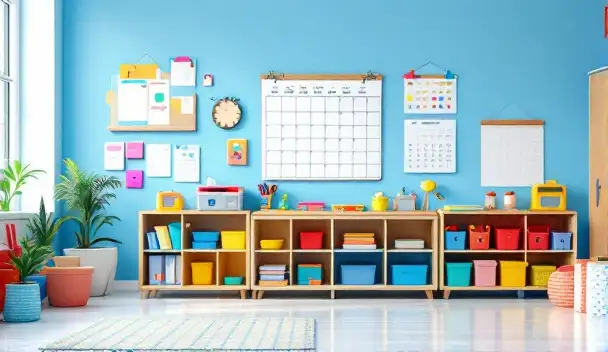
Teaching Organizational Skills Using ABA Approaches
Effective Strategies for Teaching Organization with ABA

How ABA Therapy Improves Transitions Between School Activities
Enhancing School Transitions for Students with Autism

Teaching Self-Correction Skills Through ABA Techniques
Empowering Autism Interventions with Self-Correction Skills

How ABA Supports Social Communication In Group Settings
Enhancing Social Skills Through Evidence-Based Interventions

How ABA Therapy Builds Self-Care Independence In Teenagers
Empowering Teens Through Structured Interventions

Teaching Time Management Concepts Through ABA
Maximizing Success: Applying ABA to Teach Effective Time Management



